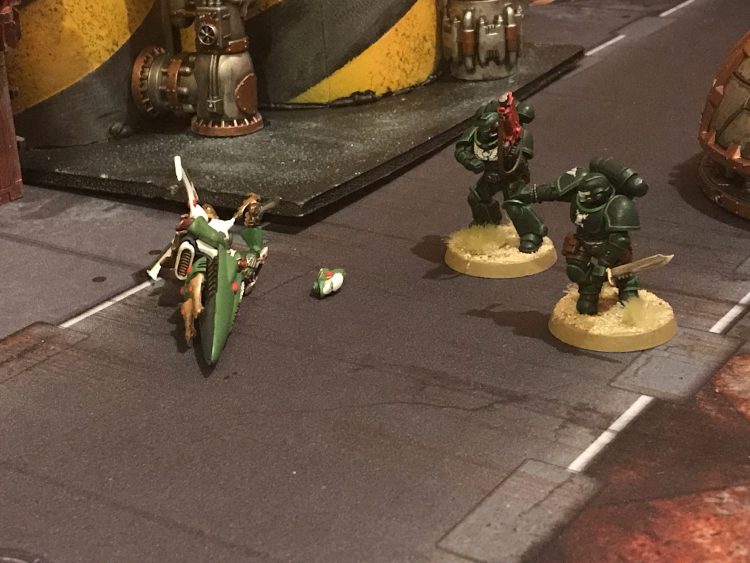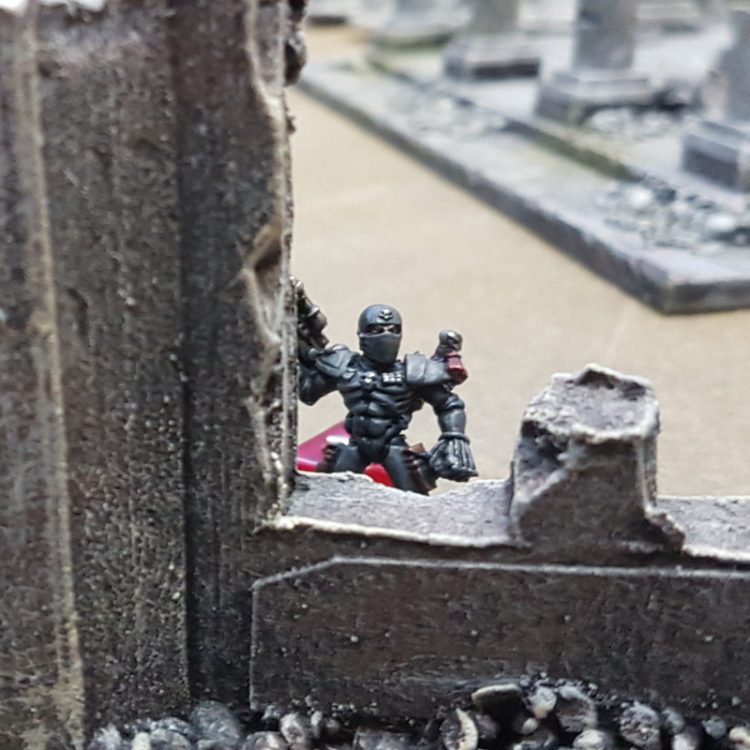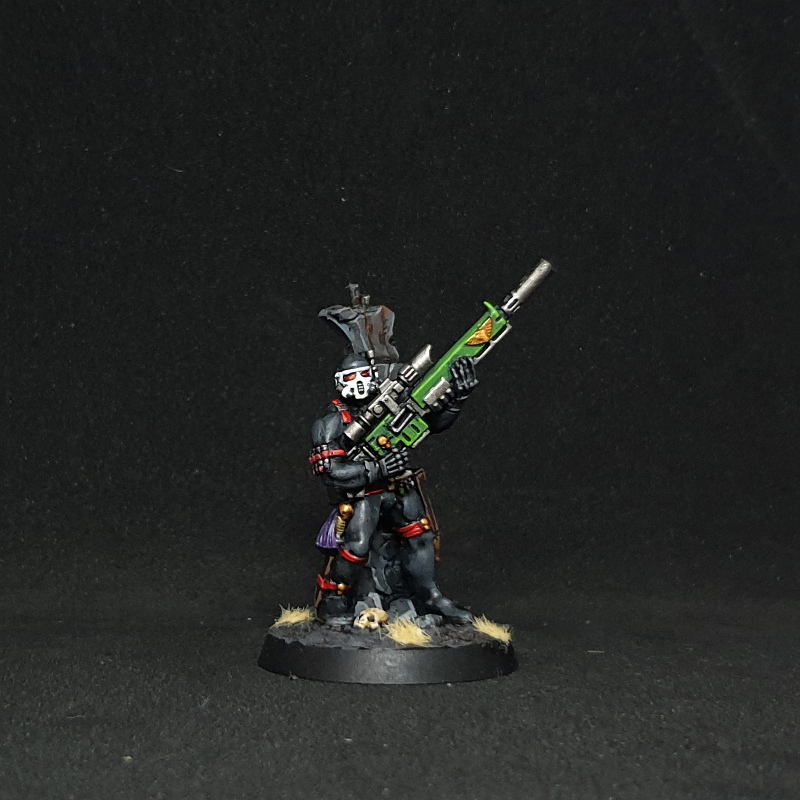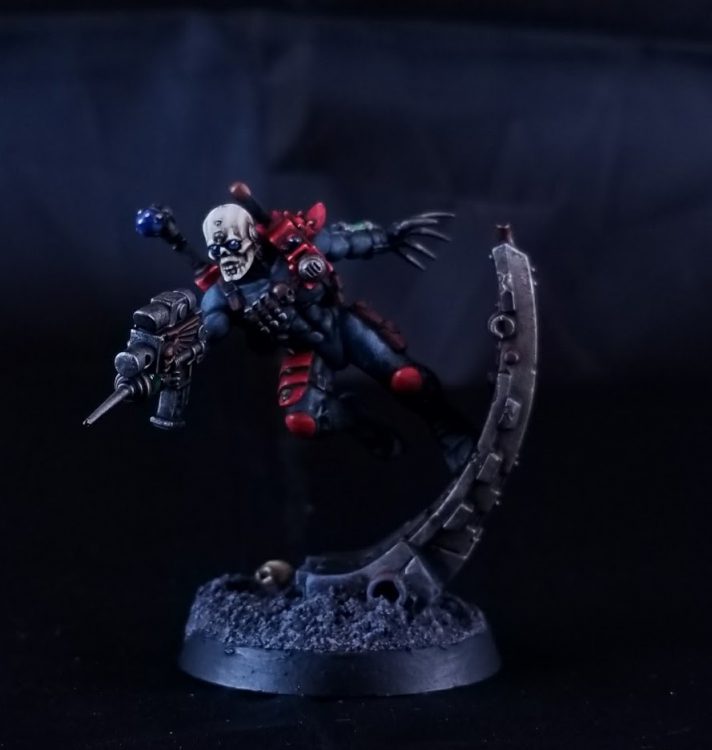The Imperial General’s Field Guide to Assassins
If you like playing 40k competitively, it likely hasn’t escaped your notice that something sinister has been stirring in the shadows…
Index Assassins has been out since the start of March, and those Imperium-playing readers who did notice it arrive (and thus haven’t been summarily terminated for a lack of vigilance and/or failed to get a copy and now have to look sadly at the Ebay prices) can now enhance their army by including these revamped and souped up killers in their army.
Probably the most exciting way to do so is via one of the new stratagems in the Index, “Operative Requisition Sanctioned”. As long as your warlord has the IMPERIUM keyword, you can spend 2 CP to use this stratagem during deployment to add an Assassin to your army (also paying the now universal 85pts the models cost). This is an extremely attractive option – one of the biggest downsides of Assassins prior to this update were that you had to dedicate a detachment to include them in your army, and that they were quite specialised. This meant you could end up with a model (or models) that wouldn’t perform in all of your matchups taking up a valuable detachment slot.
Well no longer–For 2CP you can blow all of those problems away and do it live! This obviously creates a massive headache for all of us (handsome, sophisticated) Xenos players, but is a huge boon for Imperium players, allowing them to tune their army to specific matchups, or even specific army lists on the fly. Done right, this can put the Imperial player at a huge advantage, but done wrong it’s a great way to waste 85pts, or at least let an opponent off the hook. In order to help players make this crucial decision, I’ve decided to swallow my Xenos pride and let my inner Dark Angel rise to the surface to bring you a handy guide to choosing and using your Imperial Assassin.
We’ll very quickly glance at the rules they all assassins share in common, then we’ll cover what each can do, what sort of things they’re good and bad against and, following from that, which matchups they’ll shine in.
General Rules
Assassins all have three special rules in common:
- They can all choose to “deep strike”, deploying in hiding and appearing any time after the first battle round at the end of your movement phase.
- They’re all characters – so can’t be targeted with shooting unless they’re the closest enemy model to the firing model (or the only intervening models are other characters).
- They have a universal strategem that lets you spend a CP to gain 2CP if they kill a character (or 3CP if it was the enemy warlord).
They also have relatively similar statlines, looking pretty much like your standard “quality character” like a Space Marine captain, but vary quite a bit in what equipment they have to use with those stats and what defensive gimmicks they have access to. They also each get two dedicated stratagems, giving them access to some unique tricks, which vary in how situational they are. With that in mind, there’s a limit to how many more “general” things we can say about them, so on to the run-down.
Vindicare
What They’re Good Against
Vindicare assassins are snipers that excel at killing mid-quality units/characters (being able to ignore the character targeting rules) from far away, especially ones that are:
a.) Infantry (against which their sniper rifle always wounds on 2+).
b.) Relying on invulnerable saves (which the rifle ignores, along with its -3 AP).
Each shot from the rifle is highly accurate (ignoring modifiers and so always hitting on a 2+ if the Assassin stays still) and hits hard – an initial D3 damage (or D6 on a 6 to wound) plus a chance to do some additional mortal wounds if that isn’t enough (averaging 1 per shot). There’s a whole tonne of rules applying each time this guy fires his gun, but assuming he’s stationary and you point him at an infantry model with 4+ save or worse, there’s about:
- ~62% chance of that model taking 2 or more wounds.
- ~50% chance of that model taking 3 or more wounds.
- ~35% chance of that model taking 4 or more wounds.
Multiple those probabilities by ⅚ if the target has a natural 3+ and ⅔ if they have a natural 2+.
This is obviously really good against armies with important 2-4W models running about (remember that we at Goonhammer promise you only the hottest of takes), especially if there are multiple viable targets he can shoot at once – one of his two stratagems is “Double Kill”, which for 1CP lets him shoot a second time in a turn (though it must be at a different target). Even though his chance of outright killing a target drops off substantially once they have 4 wounds, taking two swings at appropriate 4W targets in the same turn gives somewhere around a 60% chance of one of them dying miserably (learn more about combining probabilities over at TheChirurgeon’s recent article about stats and 40K), which can give your opponent absolute fits.
Characters aren’t the only good option though – 3w “elite” multi-model squads like Kataphron Destroyers and Zoanthropes (both of which have the “infantry” keyword) can also be great things to point this guy at, especially as that gives him more ways to maximise Double Kill, which is obscenely good value if you can maximise it every turn.
With this guy you probably want to strongly consider deploying him on the board rather than in Deep Strike, as he’s largely a “value” piece – you want him racking up kills early and often before your opponent manages to get something in to deal with him. He also won’t get some of his bonuses on the turn he arrives from hiding because that counts as moving, meaning he isn’t operating at “full effect” until turn 3. Unless you’ve brought him to a horrible matchup, deploying him on the board turn 1 should easily allow him to make his points back before the game is over.
What they’re bad against
For this guy to be good, there have to be things on the board that he can efficiently hurt, and your opponent has to care if he’s doing it. Armies where the vast majority of “alpha” units are vehicles (such as Knight-heavy lists or Guard tank companies) or horde armies where your opponent can cheerfully win without their characters once things get going (like Ork Boyz spam) can leave him in a target-poor environment. He does have the “Turbo-Penetrator Round” stratagem to throw a few mortal wounds at a vehicle instead of a normal wound roll, but that means you’re burning through CP to let him do anything rather than sowing unholy terror as you will against other armies, and Double Shot definitely isn’t worth spamming if all you’re doing is picking off a couple of Boyz.
Matchups
The Vindicare has an especially good chance of excelling against:
- Aeldari – Warlocks, Harlequin characters and Haemoculi are all strategic lynchpins that rely on invulnerable saves and can be taken down in 1-2 shots.
- Adeptus Mechanicus – tend to have both vulnerable characters doing important things and valuable elite infantry (Kataphrons with the Vigilus Servitor Maniple detachment are appearing in current builds).
- Genestealer Cults – glass cannon buff/assassin characters all over the place, Patriarch such a lynchpin he’s worth dedicating two turns to killing.
You should probably leave him on the bench against:
- Imperial Knights – Castellan don’t care.
- Imperial Guard – they have vulnerable characters, but they’re generally cheap, expendable and at the 4W threshold where the odds of one-shotting them drops off substantially.
- Death Guard – army wide 3+ save and 5+ FNP severely blunts his effectiveness.
As with all assassins, there will be specific lists for all of the above that could change this (except Knights here, which he’s basically always not the right choice against), and lists of armies not mentioned above that fall into either bucket. Tau are normally a somewhat weaker target for this guy, but if they’ve brought the Sa’cea Firesight Spearhead, or are on Fire Warrior spam he goes up in value.
Space Marine armies are also generally a worse target, as 5W characters in power armour (like captains) hit the dangerous threshold where you need to shoot at them for three solid turns to reliably put them down, but if you see a “Council of Librarians” across the table then you windmill slam him straight onto the table.
Top Tip
Remember that 4W is the threshold at which your chance of a one-shot kill falls off substantially, and that pulling off any more than that requires an extreme high roll. You maximise the probability of being handed some easy kills by scattering a lot of shots at medium value targets rather than lasering in on the single best, unless taking out that best target will absolutely ruin them, and it’s not a model that can profitably run and hide (like a GSC Patriarch).
Callidus Assassin
What They’re Good Against
Callidus Assassins are an odd beast in that arguably their defining feature, at least in this new world where you can choose your assassin, isn’t what they’re good at killing but how they mess with your opponent. The Callidus has two unique tricks among the pack:
- During the first battle round, whenever an opponent uses a Stratagem they have to spend an extra CP if you roll a 4+, or lose the Stratagem. You can activate this for an additional battle round for 2CP once per game.
- When the Callidus comes in, rather than having to be 9” away they can come in 9” -D6” away, potentially dropping in as close as 4” away from an enemy if you roll well.
In general, you want to choose a Callidus when the CP tax from the first ability and/or the fear factor of the second ability will provide you a significant edge over your opponent.
Callidus assassins aren’t exactly bad at killing things, especially after the huge boost the Index gives them by increasing the damage of their sword to D2, but more than any of the others here you can’t really expect them to survive long once they start doing their thing, as their defences are lacklustre. As long as you’re going after things with T4 or less, they can probably muster killing one important model if your opponent lets you put them in the wrong place, but you should assume that’s your lot if you’ve put them in harm’s way.
The one thing she does have going for her murder-wise is that she’s fast and difficult to tie down, with the built-in ability to fall back and still shoot/charge, and a stratagem that lets her advance and charge. Combining that with her Mortal Wound gun, she’s pretty efficient at bouncing through and harrassing isolated back-line units/characters of the kind often built into armies as CP farms.
The Callidus is therefore at her best when you expect your opponent to use a lot of stratagems in the first battle round or has a character they simply can’t afford to lose but also dials down in effectiveness if they have to stay closely bubbled for a few turns, and is even better when an army that meets one of these criteria also has vulnerable back-line objective holders she can harass once her other features stop being relevant.
What They’re Bad Against
Armies that don’t rely heavily on spamming stratagems early on and either don’t have characters that die easily to what she’s bringing to the table, or have the kind of model count where they can keep them continuously heavily bubbled at limited cost. She simply isn’t as good at killing stuff as an Eversor or Vindicare, so you have to be getting value out of her unique tricks for her to be the right choice.
Matchups
The Callidus can excel against:
- Imperial Knights (especially if she’s backing up knights of her own) – most common knight strategies throw a lot of CP around over the first few turns, and usually have a loyal 32 or rusty 17 in the backline that she can prey on.
- Tau – they also regularly blow through 4-5 stratagems setting up combo nonsense in the first turn, and often rely on sending small Fire Warrior units out of their castle to grab objectives, which she can pick off. Don’t send her into the castle unless you’re using ITC building rules and roll good though, as she’ll get shot to bits.
- Ork Loota Star – you know that they’re going to blow through at least four stratagems in Battle Round 1 (Mob Up, More Dakka, Shoot Twice, Grot Shields) and burning them down to 0CP before they can finish your key targets is a great way to beat them. They also often have a reliced up Big Mek in tow, a great target for her.
- Harlequins – love spamming strats, and she can make a horrible mess of all of their characters thanks to them being T3 and invuln reliant.
The Callidus will likely struggle against:
- Drukari – the popular Talos or plane/Ravager based lists don’t really need that many stratagems early on to function, and the main character they’ll be very sad if you kill (the Black Heart Archon) literally wants to be surrounded by Ravagers at all times. You might be able to go after splashed in Bikeseers, but a Vindicare will do that better.
- Custodes – she’s horrible at killing T5+ things, weak against 2+ saves and they don’t really chew through stratagems “in-game”.
- Ork Boyz Spam – they don’t use many stratagems in the first battle round, and their most relevant character interaction (getting off their first “Da Jump” cast) is done and dusted before she can interfere.
More than any of the others, you really have to look at your opponent’s list and decide if the Callidus is worth it – hopefully the inclusion of variant Ork lists in both categories above helps illustrate that.
Top Tip
Before bringing the Callidus in, make sure you have a plan for how to use her correctly if you roll low or high on the distance, because you “commit” to deploying her when you roll the dice. If you find that there would be no good options on a high roll, maybe hold her to turn 3.
Eversor Assassin
What They’re Good Against
After the changes in the index Eversors are astoundingly good at going through infantry hordes, thanks to the Neuro-Gauntlet being perfectly statted for the job, getting bonus attacks on the charge, more attacks every time they kill a model and a fight twice stratagem (even getting a helpful 6” consolidate to set up the second fight with). On average dice, an eversor fighting twice can go through 20 Ork Boyz (their optimal target) in a single fight phase, and something like 15-16 models with a native 5+ like Eldar Guardians or GSC Acolyte Hybrids.
They back this up with a 3D6” charge distance, making them pretty reliable at hitting combat, a gun that’s also great at mowing down chaff and a decent amount of survivability – they get an extra wound over other Assassins, and can turn on a 4+ FNP for a phase for only 1CP, which is useful for making sure they survive to the end of the phase and use their second fight if they’re standing among a vengeful horde. Finally, if they die they also shower Mortal Wounds everywhere. Basically, for throwing down with a horde army, an Eversor can’t be beat.
Their absolute best use within that context is as a counterpunch to armies that want to bring in and (usually) charge with a horde unit out of deep strike. These armies often rely on pulling off a “wrap and trap” (locking models in combat so they can’t fall back and thus the attacking unit can’t be shot) to keep those units “in-play” for several turns and disrupt your plans, and an Eversor strolling in out of Deep Strike and putting most of that unit in the dirt can just totally no-sell the entire strategy.
The other nice thing about the Eversor is that they have divergent enough offensive tools that they’re never totally dead – even against something like a Knight they can put 4-5 wounds in before getting stepped on once you include the Mortals on death. This can make them an attractive “fall back” choice when you can’t see any of the others as being especially good (though my personal taste is to have a Callidus in that scenario for the mind games).
As a quick aside, the Neuro-Gauntlet is almost always the correct choice to attack with over the Power Sword – it’s hugely better in a lot of situations, whereas the Power Sword is marginally better in a few. As a rule of thumb, the Power Sword is only substantially better against T3 units with a 4+ or better, or any unit with a 2+ save. In both cases, it falls behind the Gauntlet again if an invuln kicks in. Even against T7 vehicles with a 3+, while the Power Sword is better, it is by a tiny fractional sliver. Basically, if you aren’t comfortable doing the maths quickly, default to the Gauntlet outside of the situations above.
What They’re Bad Against
While we’ve just said that Eversors are almost never irrelevant, if your opponent isn’t packing any hordes as a key part of their strategy, or is heavy on vehicles, you can probably do better by looking elsewhere. You’ll probably never have a game where one does nothing if you ignore this, but over time you’d see a Vindicare or Callidus performing better for you.
Top Tip
With 3D6” charge you will often have the luxury of quite a lot of choice about where exactly he turns up in melee. Make sure to place him so that it’s difficult for your opponent to wrap too many models around him (and maybe lucking out and killing him before the second swing) but so that his 6” consolidate + 3” second pile in can definitely get him into more models if your opponent instead tries to take casualties from near him.
Matchups
The Eversor can excel against:
- Orks – Boyz are literally the perfect target, and tearing through most of a squad can massively disrupt their plans.
- Daemons – Heavily reliant on Bloodletters pulling a wrap-and-trap out of Deep Strike, which the Eversor counters beautifully.
- Imperial Guard – While he’s weak against Knights or flying vehicles, against things that can’t fall back and shoot he can make an enormous nuisance of himself, while chewing through infantry squads on the side.
The Eversor will be weaker against:
- Knights – he can hurt them, but not enough.
- Eldar Planes – skull faced man shouts at clouds.
- Tau – He needs to charge to do anything worthwhile. Let’s see what Goonhammer’s resident Tau thinks about that.

Maybe try a different plan.
Culexus Assassin
What They’re Good Against
Culexus assassins are the most specialised of the lot, as they’re really only good at two things:
- Messing with Psykers with their -2 to cast aura and anti-witch guns
- Being a pain to kill, as they set the BS of everything attacking them to 6+
They’re also the only type that didn’t get that much better on paper with the Index, actually picking up a minor nerf (their anti-cast aura now affects friendlies as well) as well as some improvements via stratagems.
The big gain for them, however, is that you now only have to take one if you actually need it, and that’s probably most valuable for them out of all of the assassins. Simply put, you are never really going to get your point’s worth if your opponent doesn’t have any Psykers with them, and being able to bring him in “on-demand” when that’s true is a huge boon.
He’s still not, if we’re honest, phenomenal at actually killing psykers – his fancy new increased damage stratagem does help a bit, but the vast majority of valuable psykers sport at least some sort of invulnerable save, which mitigates his gun’s effectiveness considerably. He’s very good, however, at messing with them – most useful powers cast on a 6 or 7, so a -2 penalty pushes them out of being cast on average. Armies with lots of psykers also often want to be getting off Smites, and positioning him carefully can block a lot of these.
Combined with his strong ability to tie up things in combat, and his other stratagem forcing something to fight last, this does also theoretically make him the most “defensively” useful assassin, shielding a key target like a Castellan from psychic and tieing up potential assailants in melee. The psychic part of this can certainly be valuable, but I think the other components are now overrated – I’m an aggressive player and I don’t like swapping out the killing power the other assassins for defensive capability unless it’s a serious boost.
What they’re Bad Against
Anything not packing serious psychic. In the old days his potential power against psychic heavy lists might have made him worth including in lists for those matches alone, but with the huge buffs to the other types, there’s no reason to bring him out in anything less than ideal scenarios.
Matchups
The Culexus can excel against:
- Thousand Sons – Heavily reliant on Smite to rack up damage (especially from Magnus). Putting him out front of your army can blunt a lot of their first turn, though watch out for Tzaangor Enlightened – the way they use bonuses to hit makes them pretty good at shooting him to death.
- Grey Knights – Obviously Grey Knights aren’t great at the moment, but if you do see them, why not make their day even worse.
- Tyranids – The last army that tends to bring psykers in volume and lean on the psychic phase as one of their damage dealing ones.
The Culexus is less good than you think against:
- Eldar – He’s obviously not bad against them, but their casters often have the maneuverability to work around a Culexus, and it may well be easier to oppress them with a Vindicare. I have played against Culexus Assassins quite a bit with my lists, and I have never found them to be that much of an issue – new Vindicares scare me a lot more.
The Culexus is bad against:
- Everything else.
Top Tip
If he’s piling in against a powerful caster (such as Magnus) alongside other friendlies, move him right into base contact and leave the other units .5” out. That way, if the target decides to stay in melee and Smite, it hits the Culexus.
Wrap Up
We hope you’ve enjoyed learning about the best way to use the Imperium’s shiny new tools, and are ready to ruin the day of Ork, Daemon and Space Elf alike. Join us in the near future when we review whichever of the Big FAQ or the Ynnari Index drops first.









